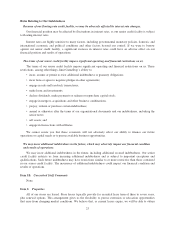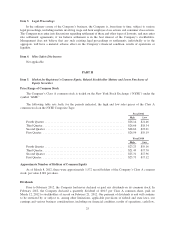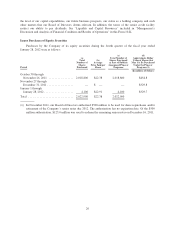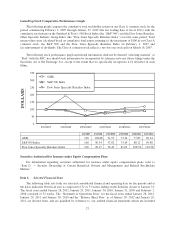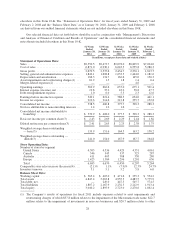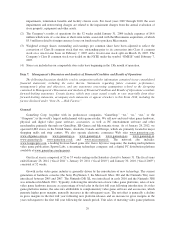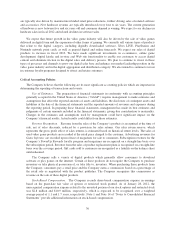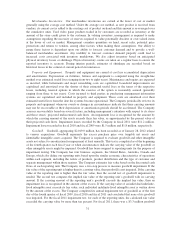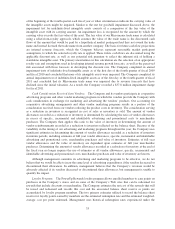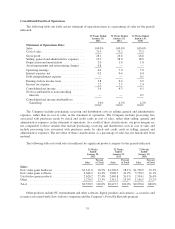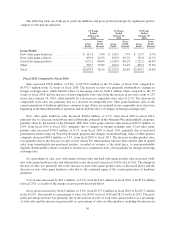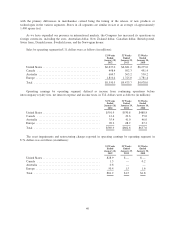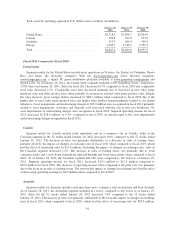GameStop 2011 Annual Report Download - page 48
Download and view the complete annual report
Please find page 48 of the 2011 GameStop annual report below. You can navigate through the pages in the report by either clicking on the pages listed below, or by using the keyword search tool below to find specific information within the annual report.impairment charge in the United States segment as a result of the exiting of a non-core business. Note 9 of
“Notes to Consolidated Financial Statements” provides additional information concerning goodwill.
The Company utilizes a discounted cash flow method to determine the fair value of reporting units.
Management is required to make significant judgments based on the Company’s projected annual business
plans, long-term business strategies, comparable store sales, store count, gross margins, operating expenses,
working capital needs, capital expenditures and long-term growth rates, all considered in light of current and
anticipated economic factors. Discount rates used in the analysis reflect a hypothetical market participant’s
weighted average cost of capital, current market rates and the risks associated with the projected cash flows.
The impairment testing process is subject to inherent uncertainties and subjectivity, particularly related to
sales and gross margins which can be impacted by various factors including the items listed in Item 1A.
Risk Factors. While the fair value is determined based on the best available information at the time of
assessment, any changes in business or economic conditions could materially increase or decrease the fair
value of the reporting unit’s net assets and, accordingly, could materially increase or decrease any related
impairment charge. While the Company does not anticipate any material changes to the projected
undiscounted cash flows underlying its impairment test, many other factors impact the fair value calculation.
Since we are required to determine fair value from a hypothetical market participant’s perspective, discount
rates used in the analyses may change based on market conditions, regardless of whether the Company’s
cost of capital has changed, which could negatively impact the fair value calculation. As we periodically
reassess our fair value calculations using currently available market information and internal forecasts,
changes in our judgments and other assumptions could result in recording material impairment charges of
goodwill or other intangible assets in any of the Company’s reporting units in the future.
Other Intangible Assets and Other Noncurrent Assets. Other intangible assets consist primarily of
trade names, leasehold rights, advertising relationships and amounts attributed to favorable leasehold
interests recorded primarily as a result of the acquisition of SFMI Micromania SAS (“Micromania”) and the
merger with Electronics Boutique Holdings Corp. (the “EB merger”). We record intangible assets apart
from goodwill if they arise from a contractual right and are capable of being separated from the entity and
sold, transferred, licensed, rented or exchanged individually. The useful life and amortization methodology
of intangible assets are determined based on the period in which they are expected to contribute directly to
cash flows.
Trade names which were recorded as a result of acquisitions, primarily Micromania, are considered
indefinite-lived intangible assets as they are expected to contribute to cash flows indefinitely and are not
subject to amortization, but they are subject to annual impairment testing. Leasehold rights which were
recorded as a result of the Micromania acquisition represent the value of rights of tenancy under commercial
property leases for properties located in France. Rights pertaining to individual leases can be sold by us to a
new tenant or recovered by us from the landlord if the exercise of the automatic right of renewal is refused.
Leasehold rights are amortized on a straight-line basis over the expected lease term not to exceed 20 years
with no residual value. Advertising relationships, which were recorded as a result of digital acquisitions, are
relationships with existing advertisers who pay to place ads on the Company’s digital Web sites and are
amortized on a straight-line basis over 10 years. Favorable leasehold interests represent the value of the
contractual monthly rental payments that are less than the current market rent at stores acquired as part of
the Micromania acquisition or the EB merger. Favorable leasehold interests are amortized on a straight-line
basis over their remaining lease term with no expected residual value. For additional information related to
the Company’s intangible assets, see Note 9 of “Notes to Consolidated Financial Statements.”
Other non-current assets are made up of deposits and deferred financing fees. The deferred financing
fees are associated with the Company’s revolving credit facility and the senior notes issued in October 2005
in connection with the financing of the EB merger. The senior notes were redeemed in fiscal 2011. The
remaining deferred financing fees with respect to the revolving credit facility are being amortized over five
years to match the term of the revolving credit facility.
Indefinite-lived intangible assets are assessed for impairment at least annually and whenever events or
changes in circumstances indicate that the carrying value may not be recoverable. This test is completed as
32



